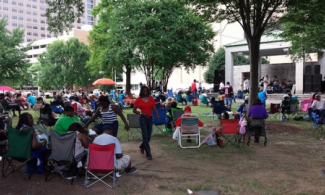
The Juneteenth celebration is a time for reassuring each other, for praying, and for the gathering of family members.
Today is June 19th and for many around the world it is just another Mid-June date of small significance. Yet the date is significant when it comes to the issue of the end of slavery in North America. In particular, the date has special relevance within the USA.
googletag.cmd.push(function() { googletag.display('content1'); });
Juneteenth, as June 19th is referenced, is the oldest known celebration commemorating the ending of slavery in the United States. It dated back to 1865, the end of the American Civil War.
It was on June 19th that the Union soldiers, led by Major General Gordon Granger, had landed at Galveston, Texas with news that the war had ended, and that the enslaved were now free. Note that this was two and a half years after President Lincoln’s Emancipation Proclamation - which had become official on January 1, 1863.
googletag.cmd.push(function() { googletag.display('content2'); });
The Emancipation Proclamation had little impact on the Texans due to the minimal number of Union troops to enforce the new Executive Order. However, with the surrender of General Lee in April of 1865, and with the arrival of General Granger’s regiment, the forces were finally strong enough to influence and overcome the resistance.
Texas at the time was sympathetic to the Confederacy, as it was a part of those eleven southern states that had broken off from the American union. It was a separate country up until 1845, and became the 28th state that year. Only a few battles of the American Civil War were fought in Texas, unlike, say, those fought in Georgia, Virginia, Pennsylvania, Maryland, and in the Carolinas. In a sense the state was mostly isolated from the major battles fought in other Confederate states during the war. So, Major General Gordon Granger’s landing at Galveston was significant for many reasons. It marked the enforcement of the end of the slave trade there, and across the country.
The reactions to this news ranged from pure shock to immediate jubilation, especially among Texas’ Black population. While many of the formerly enslaved Black Americans lingered to learn of this new employer-to-employee relationship, many left before these offers were completely off the lips of their former masters. In short, the predominant question was a simple, “what does this mean?” attesting to the varying conditions on the plantations and the realization of freedom. Even with nowhere to go, many Blacks at the time felt that leaving the plantation would be their first grasp of freedom.
The Northern states were the logical destination. For many it represented true freedom, while the desire to reach family members in neighboring states drove some to search in Louisiana, Arkansas and Oklahoma. For many Blacks settling into these new areas, as free men and women, brought on new realities. The challenges of establishing a heretofore non-existent status for black people in America were daunting. Recounting the memories of that great day in June of 1865, and its festivities would serve as motivation, as well as a release from the growing pressures encountered in their new territory.
The celebration of June 19th was coined "Juneteenth," and it grew with more participation from descendants. The Juneteenth celebration was a time for reassuring each other, for praying, and for the gathering of remaining family members. Juneteenth continued to be highly revered in Texas decades later, with many former slaves and descendants making an annual pilgrimage back to Galveston on this date.
The Civil Rights movement of the 1950’s and 1960’s yielded both positive and negative results for the Juneteenth celebrations. While it pulled many of the African American youth away and into the struggle for racial equality, many linked these struggles to the historical struggles of their ancestors. Student demonstrators involved in the Atlanta civil rights campaign evidenced this in the early 1960’s, whom wore Juneteenth freedom buttons. Again in 1968, Juneteenth received another strong resurgence through Poor Peoples March to Washington D.C. Rev. Ralph Abernathy’s call for people of all races, creeds, economic levels and professions to come to Washington to show support for the poor. Many of these attendees returned home and initiated Juneteenth celebrations in areas previously absent of such activity. In fact, two of the largest Juneteenth celebrations founded after this March are now held in Milwaukee and Minneapolis.
Juneteenth is still observed today across the Americas, but it does not have the reverence, or the large numbers, of such gatherings of Black Americans as, say, the West Indian Carnival of Brooklyn, New York, in early September, for example. Many Black Americans almost have to be reminded of the significance of the date. Yet the celebrations do go on across the Americas.
On this date of 2014 Juneteenth is a 149-year old cerebration coming into greater observance by a new generation connecting both their African and American roots. Juneteenth remains an important date for millions of Americans of African descent throughout the Americas.
Next year is the 150th anniversary of Juneteenth. Nationally, there have been several campaigns to raise awareness ahead of this anniversary. The campaign is lead by websites like Juneteenth.com, and Rev. Ronald V. Meyers, Sr., M.D., Founder of the National Juneteenth Observance petition.
googletag.cmd.push(function() { googletag.display('comments'); });